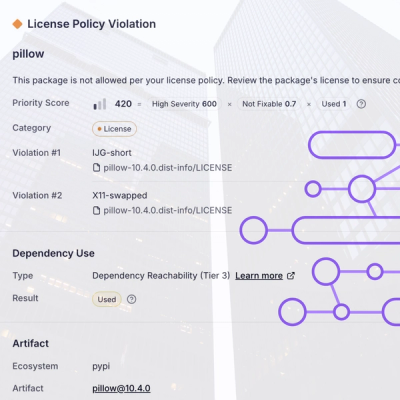
Research
/Security News
Critical Vulnerability in NestJS Devtools: Localhost RCE via Sandbox Escape
A flawed sandbox in @nestjs/devtools-integration lets attackers run code on your machine via CSRF, leading to full Remote Code Execution (RCE).
angular-x-image-viewer
Advanced tools
A configurable Angular image viewer component, compatible with Angular 7.x+
A configurable Angular image viewer component, compatible with Angular 7.x+
To use default configuration, simply import the ImageViewerModule into your module, like so:
import {
AngularImageViewerModule
} from "angular-x-image-viewer";
@NgModule({
//...
imports: [
//...
AngularImageViewerModule
],
//...
})
Then, add the component to your template, providing an array of image URLs. You can also optionally add an index, to indicate which image should be shown first. The default will be the first item in the array.
<angular-image-viewer [src]="images" [(index)]="imageIndex"></angular-image-viewer>
By default, the image viewer will fill its container. If you wish to restrict the size, simply place it within a div, and set the size constraints on the div.
Configuration can be provided at the module level (by passing the object as an argument to forRoot() , or at the component level, by passing it as the config input. Any configuration provided at the component level will override that which is set at the module level.
The configuration object is structured as below. All values are optional, and if omitted, the default value shown below will be used.
{
btnClass: 'default', // The CSS class(es) that will apply to the buttons
zoomFactor: 0.1, // The amount that the scale will be increased by
containerBackgroundColor: '#ccc', // The color to use for the background. This can provided in hex, or rgb(a).
wheelZoom: true, // If true, the mouse wheel can be used to zoom in
allowFullscreen: true, // If true, the fullscreen button will be shown, allowing the user to enter fullscreen mode
allowKeyboardNavigation: true, // If true, the left / right arrow keys can be used for navigation
btnIcons: { // The icon classes that will apply to the buttons. By default, font-awesome is used.
zoomIn: 'fa fa-plus',
zoomOut: 'fa fa-minus',
rotateClockwise: 'fa fa-repeat',
rotateCounterClockwise: 'fa fa-undo',
next: 'fa fa-arrow-right',
prev: 'fa fa-arrow-left',
fullscreen: 'fa fa-arrows-alt',
},
btnShow: {
zoomIn: true,
zoomOut: true,
rotateClockwise: true,
rotateCounterClockwise: true,
next: true,
prev: true
}
};
To add additional buttons use the following
<angular-image-viewer [src]="images"
[config]="{customBtns:[{name: 'link', icon: 'fa fa-paperclip'}]}"
(customImageEvent)="handleEvent($event)">
</angular-image-viewer>
handleEvent(event: customImageEvent) {
console.log( `${event.name} has been click on img ${event.imageIndex + 1}` );
switch (event.name) {
case 'print':
console.log('run print logic');
break;
}
}
Note: This package is built using the idea from ngx-image-viewer(https://github.com/jpilfold/ngx-image-viewer). It has advantage that it uses latest dependencies which fixes Issue #23 & #29 i.e related to FullScreen Image.
Also in recent version 2.0.0 this has made the some improvements in making image container flexible. By Default which takes height of 98Vh, you can control that property by passing additional input property screenHeightOccupied in pixels. Example:
<angular-image-viewer [src]="images" [(config)]="config" [(index)]="imageIndexOne"
[screenHeightOccupied]='0' (customImageEvent)="handleEvent($event)" >
</angular-image-viewer>
FAQs
A configurable Angular image viewer component, compatible with Angular 7.x+
The npm package angular-x-image-viewer receives a total of 606 weekly downloads. As such, angular-x-image-viewer popularity was classified as not popular.
We found that angular-x-image-viewer demonstrated a not healthy version release cadence and project activity because the last version was released a year ago. It has 1 open source maintainer collaborating on the project.
Did you know?

Socket for GitHub automatically highlights issues in each pull request and monitors the health of all your open source dependencies. Discover the contents of your packages and block harmful activity before you install or update your dependencies.

Research
/Security News
A flawed sandbox in @nestjs/devtools-integration lets attackers run code on your machine via CSRF, leading to full Remote Code Execution (RCE).

Product
Customize license detection with Socket’s new license overlays: gain control, reduce noise, and handle edge cases with precision.

Product
Socket now supports Rust and Cargo, offering package search for all users and experimental SBOM generation for enterprise projects.